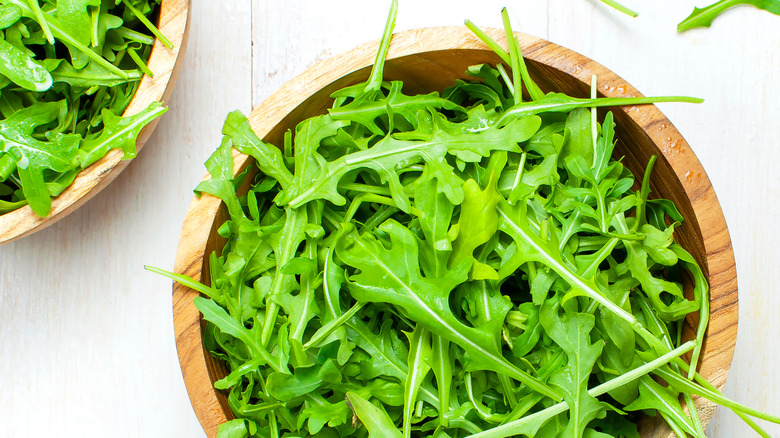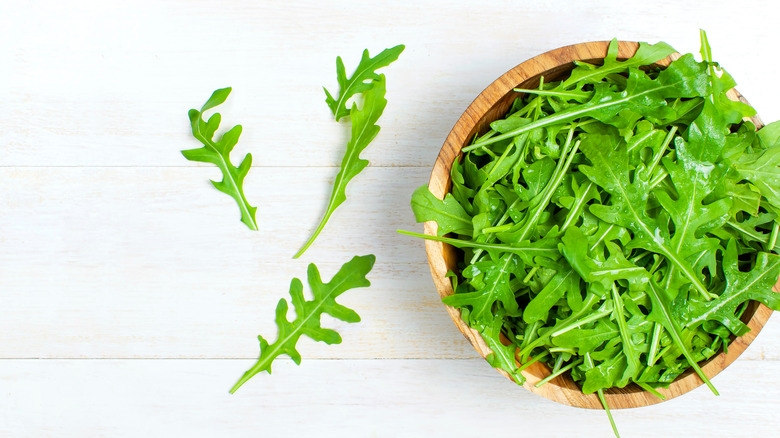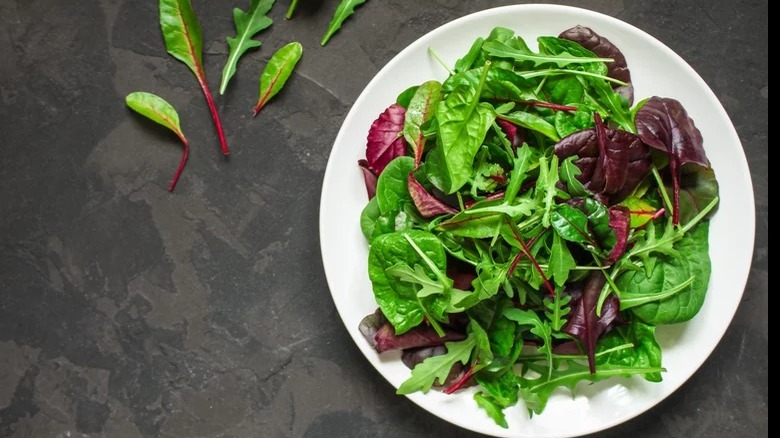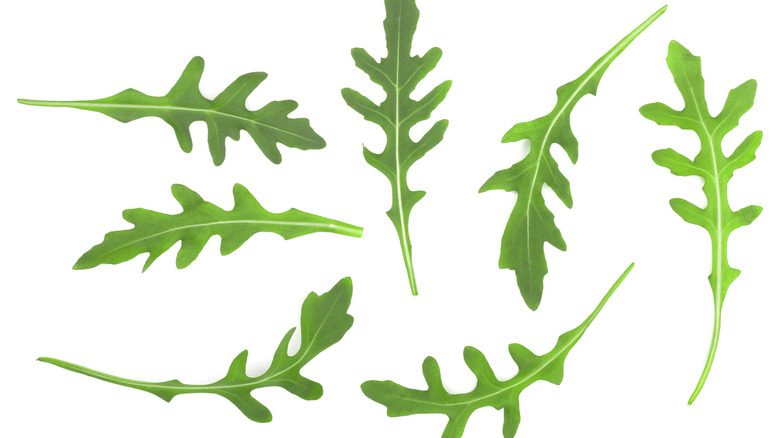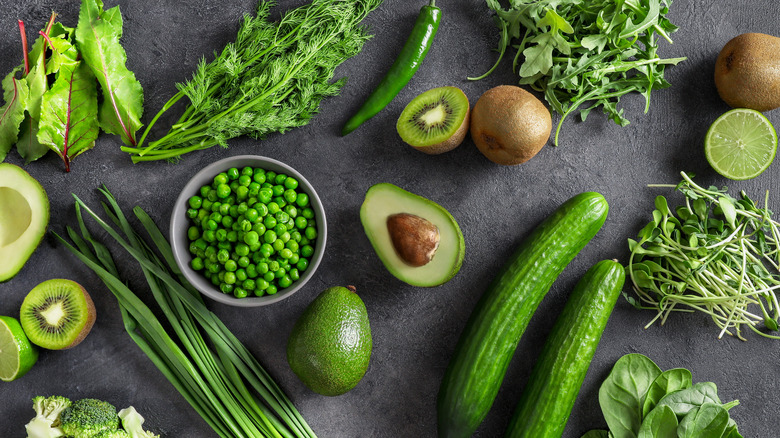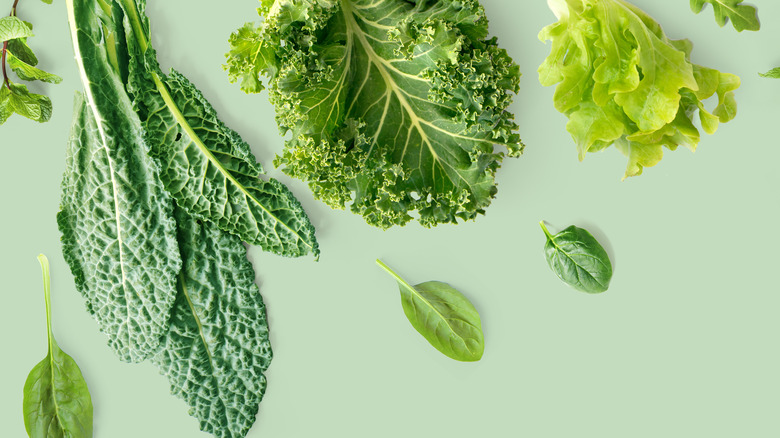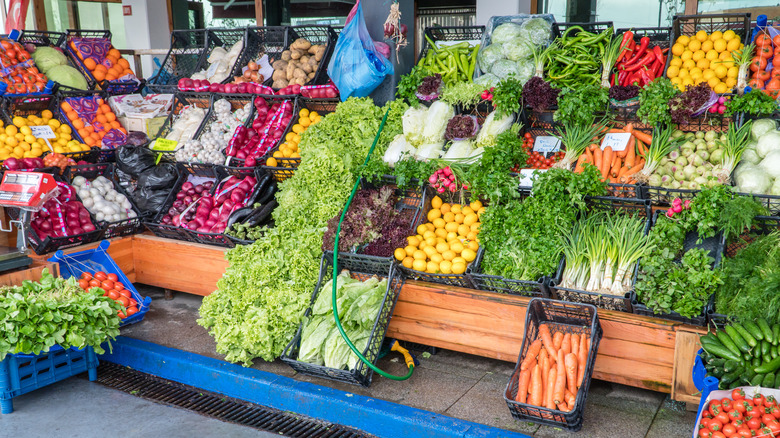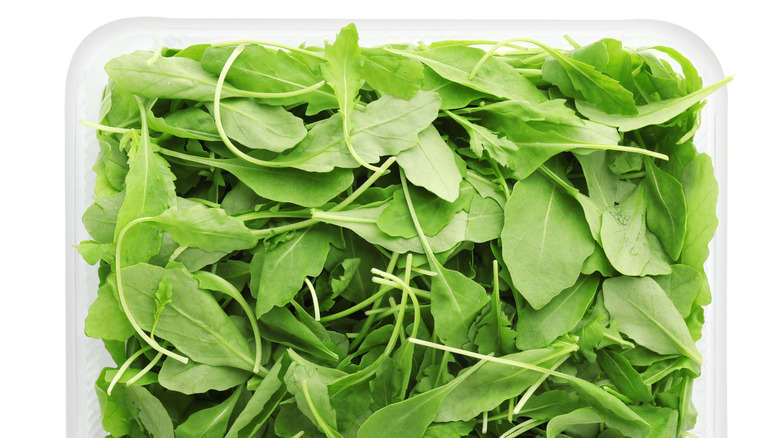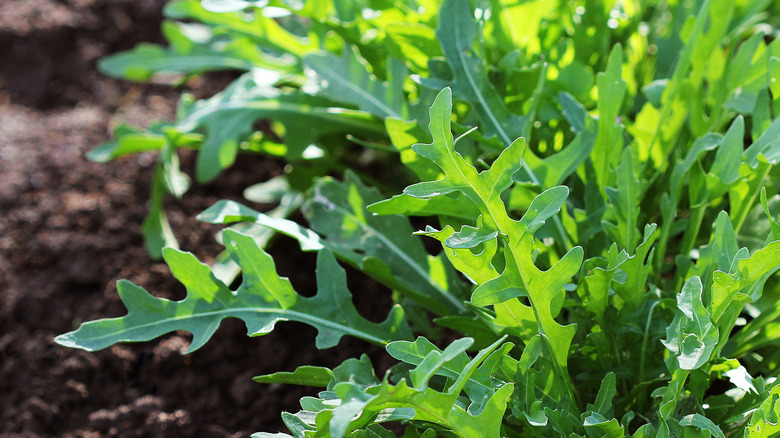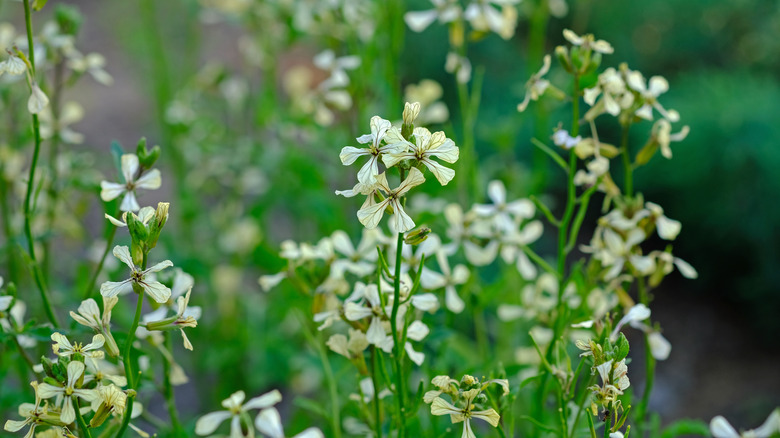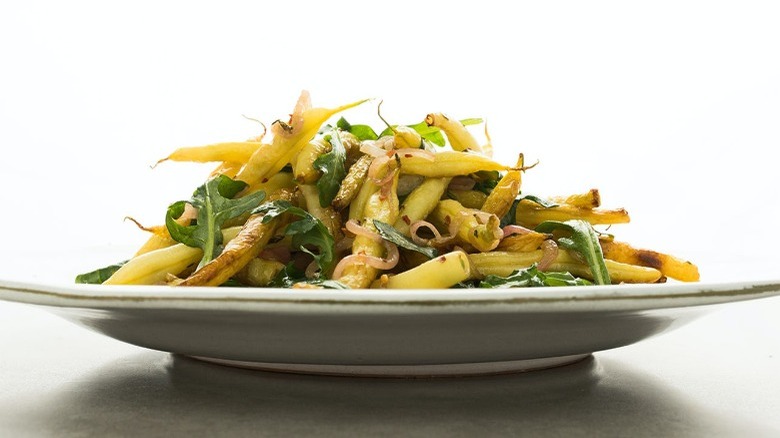Everything You Need To Know About Arugula
Leafy green vegetables are notorious for being healthful, nourishing foods. However, their status as main course taste-makers is not quite so reputable. It's often a choice when choosing salads and greens: flavor versus nutrition. Excitement versus blandness. It's tough to find foods that cover all the reasons for eating. Fortunately, arugula's tangy taste and wholesome composition make it a must-have veggie for every occasion.
Arugula (eruca vesicaria sativa) is a globetrotting garden good that packs a punch for the palette and carries a heavy load of nutrients and minerals for the body. As a fresh leafy green with a semi-sturdy texture, arugula is a versatile cooking ingredient and an essential raw food to keep on the ready. Arugula is known by many names across the world, and in America, it has had a rough time in the court of public opinion over the past several years. Yet, pound for pound, arugula is one of the best vegetable greens growing.
So, what makes arugula so fantastic really, and how do you get your hands on the best of it? There is much to know about this unique plant. These facts will do more than pique your interest.
What is arugula?
Leafy green arugula is an important ingredient for so many cooks and chefs. It is a favorite in pasta, primetime on pizzas, and essential for salad mixes. How can one hope to narrow down the existence of such a nutrient-dense, flavor-packed ingredient into a single category? With an encyclopedia of course.
The English refer to arugula as "rocket," but Encyclopedia Britannica calls arugula an herb. It is classified within the Brassicaceae plant family, which is the mustard family of flowering plants that exist under the order of Brassicales. Members of the Brassicaceae family stretch across the world of edible plants to include cabbages, broccoli, cauliflower, radishes, and of course: arugula.
As part of the Eurca genus, arugula falls under a categorization that defines it as an herb, although many sources often still refer to it as a vegetable. In most food preparations it is considered and consumed as the latter. Arugula plants produce a flower but it is the leaves that are harvested and eaten raw or cooked. Arugula's particular flavor is as distinct as the cuisine from its native region.
The history of arugula
Commercial producers B&W Quality Growers write that arugula stems from the Italian coast of the Mediterranean. The environment of the region was a perfect cradle for the herb to be cultivated before it spread with the Roman Empire through Turkey, Persia, and Europe. Etymologists note when arugula moved through France it became known as "roquette," eventually reaching Britain to be renamed "rocket." Like if Richard Branson had named the plant.
A 2007 quip about the price of produce from then-presidential hopeful Barack Obama pushed arugula into the partisan light of American food culture. For many, "Arugulagate" was their first hearing of the leafy green, despite its ancient appearance in both the Bible and the Talmud. However, arugula has been in the States for a long time.
Sam Dean of Bon Appetite writes that when arugula reached America it was with Italian immigrants who referred to it as either "rucola" or "aruculu" depending on where they arrived from. Since many more Southern Italians were arriving to America, it was "aruculu" which prevailed, eventually becoming "arugula". Today in Italy the proper word for arugula is "rucola." Surely, arugula by any other name still tastes as sharp.
What does arugula taste like?
For as many ways as there are to name arugula, there are as many ways to taste it. As the Independent reports, those differences can come down to genetics.
Mashed describes arugula leaves as having a pungent, peppery flavor that varies in strength depending on the type of arugula and the conditions it was grown under. The research covered by the Independent shows that the reason for this spicy flavor is a chemical compound called isothiocyanates, which acts as a natural defense from wild herbivores (and an attractant for hungry human vegetarians).
The isothiocyanates compound is received differently by humans depending on their genomes. Some eaters may find arugula intensely bitter while others enjoy the punchy taste. Those peppery notes of arugula may intensify if growing conditions have been hot, dry, and sunny enough to make the herb grow rapidly. Arugula's flavor is strongest when consumed raw but can be cut when cooked or paired with the right contrasts.
Arugula's flavor depends on the variety
Another aspect that can affect arugula's flavor is the variety of the herb that is being grown and eaten. Similar to lettuce and kale, arugula is a green that comes in a multitude of shapes and sizes. Each type can create a different flavor. Reporting from the Guardian suggests that the strength of arugula's flavor falls most significantly between two cultivars: The broad-leafed eruca sativa and the spear-shaped selvatica (or "sylvetta").
Gardening resources from Cornell University detail upwards of 20 cultivars of domesticated and wild arugula (meaning there are 20+ kinds to be eaten). Some, like the "rucola selvatica" variety, have a nutty flavor. Other cultivars such as "even star arugula" deliver a particularly biting flavor. So if one variety isn't particularly pleasing, perhaps you just need to try another? If you like the eye-opening taste of this herb, wait until you read about what it does for your body.
Arugula is incredibly nutritious
Arugula's vibrant flavor was once believed to provide certain vitality-inducing properties. In both ancient Rome and Egypt, the powerful flavor of "rocket" herb was considered an aphrodisiac. Evidence of that effect has never been scientifically confirmed, but plenty more information about arugula's health benefits have been uncovered since the time of antiquity.
In addition to previously mentioned isothiocyanates compounds, arugula leaves contain a high amount of glucosinolates. Medical News Today reports on research that has found a connection between glucosinolates and the body's ability to stop the cancer-creating enzyme HDAC.
Not only can a diet containing arugula potentially fight cancer, but it can also help improve blood health, stave off osteoporosis, and benefit general nutrition. Healthline writes that arugula is loaded with Vitamins A, B, C, and K as well as potassium and calcium. Between them, these nutrients offer antioxidant properties and aid in the body's uptake of iron, electrolytes, and folate. Consuming the minerals in arugula can help improve blood, kidney, liver, heart, eye, and nervous system functions. Beyond all the things you cannot see, nutritionists at LiveStrong include arugula as a low-calorie food that aids in managing weight.
Arugula versus other leafy greens
In today's superfood world, it can be hard to know what foods are truly nutrient-dense and what foods are riding a wave of green-washed marketing. Like many other leafy plants from the Brassicaceae order, arugula is packed with micronutrients that offer acute health advantages. If every green is super-powered, why pick arugula over the others?
LiveStrong recommends starting with the Aggregate Nutrient Density Index (ANDI) when choosing your vegetables. ANDI calculates an individual health rating score for foods by comparing their nutrient content versus the number of calories each provides. Amazingly, arugula is in the top 10 of the index with a score of 604 of 1,000. Healthy, and delicious.
Apart from the bodily benefits of eating arugula, the flavor and versatility of this herb make it a unique and unmatched choice for dining. Arugula shines in salad situations where spinach, kale, or Swiss chard may be too tough. In dishes where a lighter green is desired, arugula holds its texture while lettuce wilts. It adds layers of taste when mustard greens or collards may be too strong, and the ways to prepare arugula are as diverse as the flavors.
What are the common ways to cook and use arugula?
According to the Urban Farming Institute, arugula is cooked in many different ways across the world. For example, in Cyprus, arugula can be found folded into omelets called rokkas and in Northern India arugula seeds are pressed into oils and used for pickling. In many places, arugula is consumed as a raw ingredient to counteract bitter notes in salads.
Other common ways to cook arugula include steaming, simmering, wilting, and sautéing. Thrive Cuisine recommends cooking your arugula in a vegetable steaming basket. This method can help reduce the peppery flavor and prevent your greens from overcooking. Simply place the greens in the steamer and let hot water cook them into a smaller size for 2-3 minutes. Sauté arugula in a pan with a touch of oil for wilted leaves that are perfect additions to pastas and gnocchi recipes like this one from Mashed.
As with many other plant foods, arugula goes great when put on the top of pizza. It cooks fast, so add it as a post-baking garnish, or in the last minute. Now that you know the utility of arugula, the next step is to get some.
Where can I get fresh arugula?
Fortunately for American eaters, arugula is not as difficult to find as it once was. In addition to receiving a place on most modern grocery store shelves, arugula has a growing presence in American gardens and farmer's markets across the nation.
Fresh arugula can be found along with the salad greens in most supermarkets. Larger cruciferous greens like kale or collards may be sold in unpackaged bunches, but "rocket" is often boxed up within a plastic bag or container. When purchasing arugula, Bon Appetite recommends looking through the container for any wilted or yellowing leaves, which indicate spoilage. Life-hacks site Experience Life also suggests looking for excess water within the produce packaging. Too much moisture can be a sign of veggies on the verge of rotting.
The most basic tip to identifying quality arugula is to look for brightly colored green leaves. The greenest pieces of arugula you'll find are the ones that have just been harvested by a neighbor, a local farmer, or from your own garden. Still, the best greens are the available kind. Arugula can have a good fridge-life with the right storage tips
How to store fresh arugula
Whether you've purchased arugula in a store or grown it yourself, proper storage is your way to reduce waste and enjoy your piquant produce in full flavor. Mashed has a few tips for keeping your arugula in top condition regardless of if it was bought in bulk or pre-packaged.
If you're bringing home loose arugula from the garden, farmer's market, or bulk produce bin at the grocery, follow these steps. First, wrap up your arugula in a paper towel. Keep it unwashed, because you'll want to prevent the leaves from getting soaked. Place the bundle in a plastic bag and stash it in the crisper. This method should hold the quality of the arugula for two days. The folks at Williams Sonoma recommend using a damp paper towel, so the choice is yours there.
Storage is easiest if you have purchased arugula that was already in a container. Bagged arugula can last up to five days, so can arugula stored in a plastic clamshell. Arugula is a tricky plant to keep fresh. If you're purchasing with a waste-free focus, don't wilt away. Unlike regular lettuce varieties, there are several ways to preserve arugula too.
Ways to preserve arugula
Like a lot of things in today's markets, arugula production has been hitting some snags and shortages recently (via the Counter). When that stacks on top of the fact that arugula has a fairly short shelf life, it can become hard to acquire or keep arugula on hand. Knowing how to preserve arugula can be an important piece of kitchen knowledge in advance of those circumstances.
There are many ways to make the most of your arugula without having to eat it all fresh out of the store. It may have been a shock to learn that arugula is an herb rather than a vegetable, but here is where that difference becomes handy. As an herb, arugula can be dried or dehydrated. The educational site, Little Sprouts Learning details the ways to turn your arugula (and similar greens) into seasonings.
Another inventive way to preserve arugula is by mincing or pulling it apart and then freezing the bits into olive oil ice cubes. These ready-to-cook herb blocks can help you get a quick start on dinner, full of all the flavors of fresh produce.
How to grow arugula in the garden
If you haven't been able to find arugula in your grocery or local farmer's market, it may be time to sow it yourself. As part of the mustard family, arugula is a hardy crop that can survive on near-neglect, though certain conditions certainly help it prosper. As The Old Farmer's Almanac puts it, growing arugula is easier than you think:
"Rocket" makes for a delicious green that can be harvested in summer, fall, and even winter. Six hours of sunlight and slightly acidic, well-drained soil are perfect conditions to foster a crop. First and last plantings of the year can handle soil temperature down to 40°F and the first cutting of arugula is ready to harvest six to eight weeks after sowing. Since each seed only needs to be 1-inch apart, arugula can grow densely packed with other salad greens.
Once the leaves reach 3 to 4 inches long, congratulations: You've grown baby arugula. Harvesting the outside leaves of the plant rosette promotes continued growth, leaving you with replenishing fresh food. In addition to these tips, gardening site the Spruce calls for consistent watering and has advice for growing arugula indoors.
Yes, you can grow arugula indoors
The Spruce identifies arugula as a densely growing plant that has shallow roots. Those characteristics are perfect space-saving attributes for potted indoor plants, especially the kind being grown as a renewable food source. Best of all, indoor growing can introduce you to yet another side of arugula.
Homeguides from SF Gate shares important specifics to consider when planting arugula indoors. For example, growers should try to position their plants at a south-facing window to maximize sun exposure. If the seedlings (or starter transplants) aren't getting approximately six hours, supplemental UV light may be needed. Shorter roots will result in shorter leaves which means you don't need great space to get a great crop. That can also help the plants avoid "bolting," although don't go too short on the planting container. Pots should be a minimum of 4 inches deep.
The most interesting thing about growing arugula indoors? You can get many of the health and flavor benefits of the spicy herb in less time by harvesting the plant as a microgreen. These miniature sprouts are full of minerals and also add a layer of umami to everything from eggs, to sandwiches, to dinner courses.
Don't ignore arugula flowers
The lobed or spear-shaped leaves of an arugula plant are what gets most attention in the culinary world. Smaller, tender leaves are considered gourmet. Yet, there is more to arugula plants than the small bits. Arugula goes to seed in a process called "bolting" which results in many different kinds of delicious.
Culinary blog Food52 writes that some of the most intensely flavored arugula leaves are the larger ones that have bolted. These tougher leaves stand up best in sautées, delivering a spicy note to pastas and even a stir-fry. Beyond these leaves, the edible uses of arugula extend further to the crowning flower of the plant. Organic Lesson writes that the flower signifies an end to growth. For cooks, it means one final pop of flavor.
Along with finding a use for leaves that could be considered overgrown, Food52 details the value of arugula flowers too. The cream and yellow-colored florets add a mild arugula note when applied as a garnish. Often, these petals have a deeper, nuttier flavor than the green. All in all, it is an earnest way to get the most out of your new favorite garden herb.
What pairs best with the flavors of arugula?
Arugula's amazing flavor is a versatile companion to any number of foods, though there are certain profiles that will inevitably pair best. After all, "rocket" is an ingredient that has been toyed with since the Biblical age.
According to food writers at NPR, arugula's involved spiciness is perfect for "complementary foods such as salty pancetta and anchovies." Of course, those pairings are based on the Mediterranean roots of arugula. Salty, fatty combinations are natural to pair with the cleansing taste of arugula. Other common matches you'll want to enjoy with this aromatic herb are citrus and vinegar. Acidic flavors play best off of arugula's lively expression. This wax bean and arugula salad is a great side dish or starter, starch balancing the herbaceous bite. A gluten-free Pasta Agrodolce with Cubanelle peppers is another creative way to nosh some arugula.
The beauty of arugula is that although it seems exotic and tastes extraordinary, the ways to grow and eat it are simple. Arugula is a rudimentary ingredient in every way other than how it hits the palette. Take what you know, go forth, and grub like an arugula aficionado.
